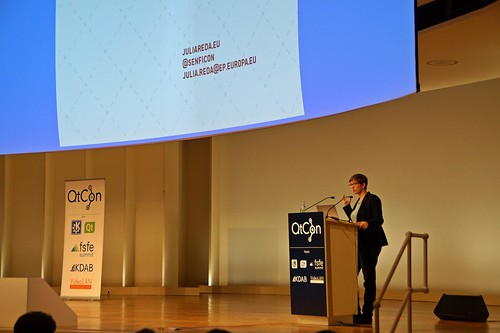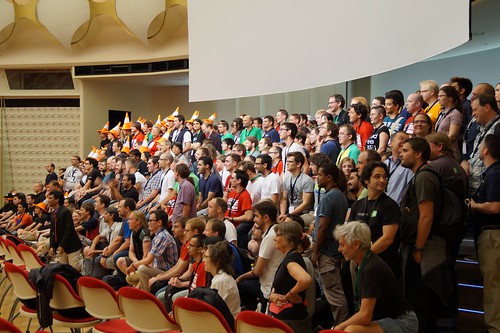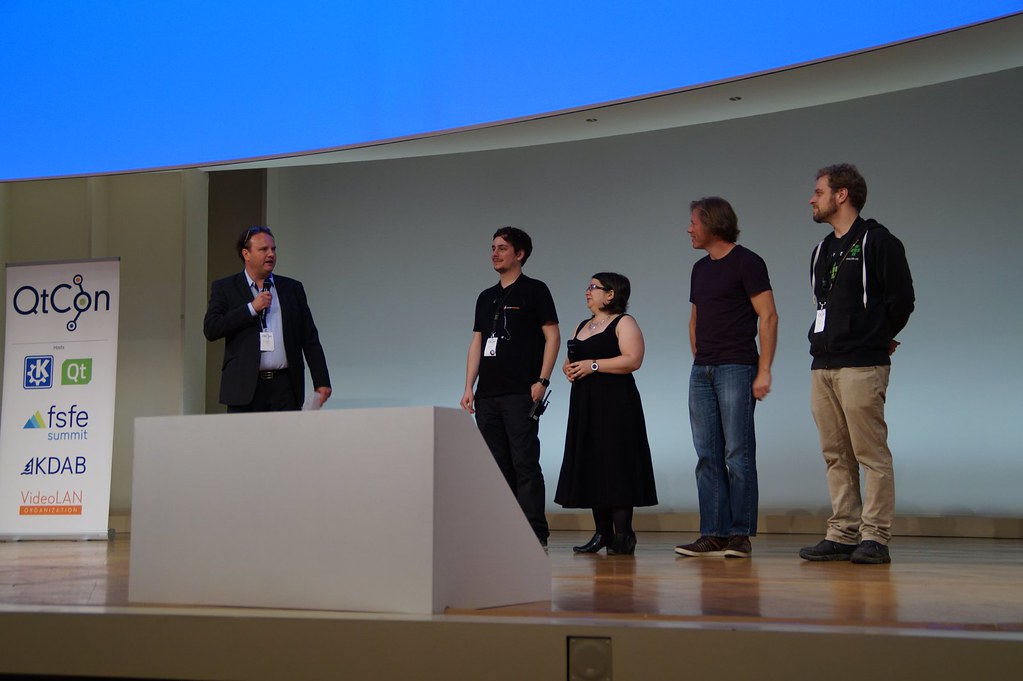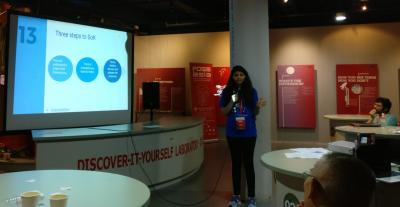Applications
-
GNOME.Asia Summit 2017 to be hosted in Chongqing China
(GNOME)
The GNOME.Asia Committee is proud to announce that the upcoming GNOME.Asia Summit 2017 will be hosted in Chongqing, China on Oct 14-Oct 16. The GNOME.Asia committee has decided on the city of Chongqing because it uniquely represents an important theme: open source without any restriction of time, space, or location. Chongqing is located in the […]
-
Plasma 5.17 is out!
(KDE)
KDE launches the new version of its acclaimed desktop environment, Plasma 5.17.
Plasma 5.17 is the version where the desktop anticipates your needs. Among many new features and improvements, your desktop now starts up faster; Night Color, the color-grading system that relaxes your eyes when the sun sets, has landed for X11; your Plasma desktop recognizes when you are giving a presentation, and stops messages popping up in the middle of your slideshows; and, if you are using Wayland, Plasma now comes with fractional scaling, which means that you can adjust the size of all your desktop elements, windows, fonts and panels perfectly to your HiDPI monitor.
The best part? The hundreds of improvements that have made their way into Plasma 5.17 do not tax your hardware! Plasma 5.17 is as lightweight and thrifty with resources as ever.
Check out the official release announcement for more features, improvements and goodies, or browse the full Plasma 5.17 changelog to read about every single change. You can also experience Plasma 5.17 for yourself and install one of the many distributions that offer Plasma.
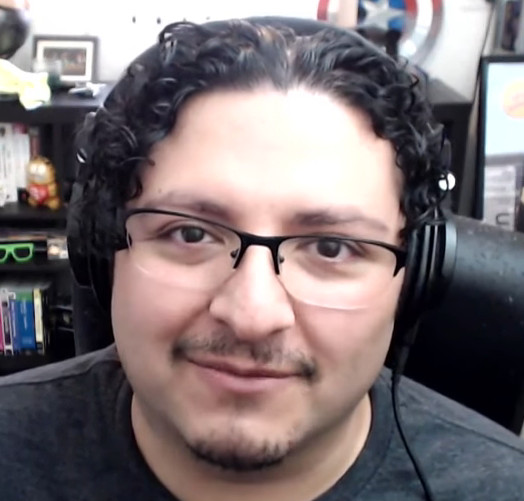
Guillermo Amaral The Plasma 5.17 series is dedicated to our friend Guillermo Amaral. Guillermo was an enthusiastic KDE developer who rightly self-described as 'an incredibly handsome multidisciplinary self-taught engineer'. He brought cheer to family, friends and colleagues. He lost his battle with cancer last summer, but will be remembered as a friend to all he met.
-
5 Things to Look Forward to in Krita 4.0
(KDE)
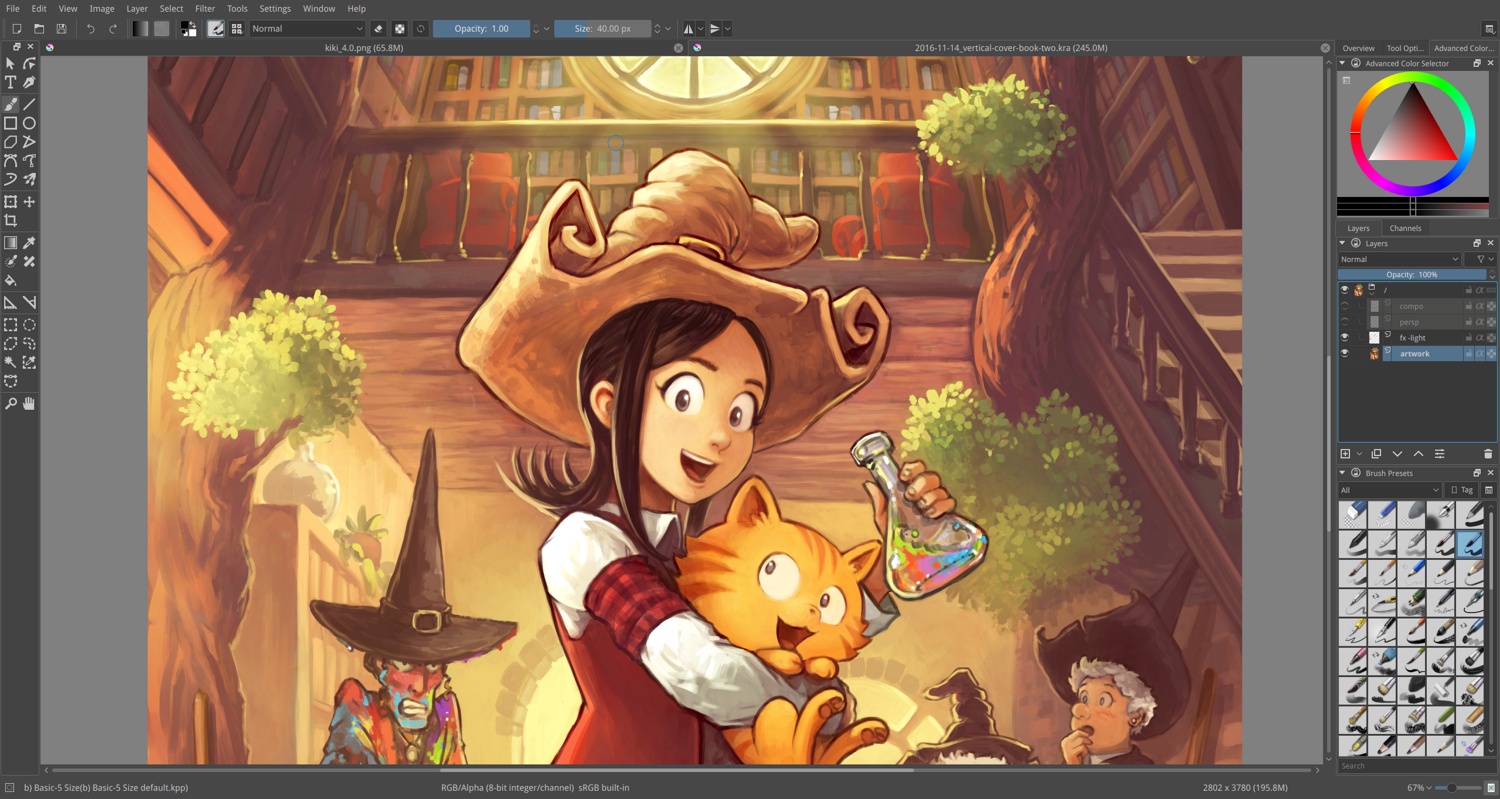
That Krita has become one of the most popular applications for painting among digital artists is an understatement. The great thing is that, with every new version, Krita just gets better and better. The latest release is a perfect example of that. Check out what you can look forward to in the new 4.0 version:
1. SVG for Vector Tools
Krita 4.0 will use SVG on vector layers by default, instead of the prior reliance on ODG. SVG is the most widely used open format for vector graphics out there. Used by "pure" vector design applications, SVG on Krita currently supports gradients and transparencies, with more effects coming soon.
Krita 4.0 also includes an improved set of tools for editing objects created on vector layers, letting you tweak the fill, the shape, and other features of your vector elements.
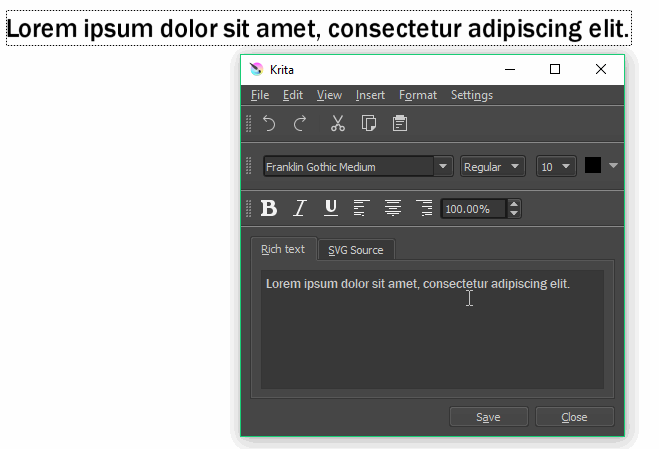
The text tool is now more reliable and more usable. 2. New Text Tool
The usability of the text tool has been vastly improved. The tool has been re-written to be more reliable, and has a better base for future expansion. As it also follows the SVG standard (instead of the prior ODT), it is compatible with more design applications.
3. Python Scripting
Krita now comes with a brand new Python scripting engine. This engine lets you write snippets of code that create and manipulate images, add dockers, entries to the menu, and much more. To get you started, the creators have included a large amount of example scripts. In Krita's Settings dialog, you can enable or disable Python plugins. Check out the manual and learn how to pythonize your Krita.
Note that this is the first release to include scripting, so it is very much a work in progress at this stage. Be advised that some things will work, but, for those that don't... Please tell the team!
4. New Brushes
If there is one thing Krita is famous for, that is its wide variety of brushes. Krita 4.0 has a special surprise in that department: David Revoy, the creator of Pepper and Carrot, has added his own personal set of brushes to this version.
5. Colorize Mask Tool
The new Colorize Mask Tool allows you to quickly and easily fill areas of line-art images with color. How it works: you create the mask for your line-art image, and then paint a streak of color into each area. The feature will automatically and intelligently fill each region with the colors you painted in, saving you the trouble of having to paint everything by hand or using the "dumb" fill tool.
Take a look at the online documentation to find out more about the Colorize Mask Tool.

You can create a watercolor effect using two masked brushes. 6. Masked Brushes
Masked brushes are created by combining two brushes with each other in different ways. Say you have a brush in the shape of a heart, and then a soft sponge brush. If you combine them using the multiply operation, you will get a mix of both - a completely new brush!
Check out the manual entry for Masked Brushes to learn how this feature works.
7. Performance Improvements
As for performance improvements, Krita now multi-threads the pixel brush engine. This means Krita is now smart enough to let each of your computer's cores calculate the dabs separately, and also have them work together. Use the performance settings to let Krita know how many cores it should use. These changes only affect the pixel brush engine for now, but the feature will later be expanded to other engines like the color smudge.
Also, all brushes now have an Instant Preview threshold property. This speeds up a lot of smaller brushes that didn't have any performance improvement features in prior versions. Instant Preview will automatically turn on when the size of a brush changes by a certain amount.
Both things combined make painting with Krita a more fluid and pleasurable experience.
Okay, so that was 7 things. But the fact is that Krita has long since transcended its humble origins as a clone of other design applications, and has become the tool of choice for digital painters regardless of the platform they use.
To learn more about all the changes included in this version, visit the complete release notes for Krita 4.0 or watch the videos embedded above.
Want to help make Krita even better? Donate to the project!
-
GUADEC 2017 Registration is Open!
(GNOME)
This year, the GNOME project’s annual European conference will be taking place in Manchester, UK. Happening between 28th July and 2nd August, it will be the biggest and most important GNOME event of 2017. The conference will provide an opportunity to find out about the latest technical developments, learn new skills and tools, attend talks […]
-
Linux Application Summit 2019 about to start in Barcelona
(GNOME)
The GNOME Foundation is very excited that Linux Application Summit 2019 is about to start in Barcelona, Spain. Linux App Summit 2019 (or LAS) is a joint collaboration between GNOME and KDE which will feature 3 days of talks from prominent members of the Linux developer community from Tuesday 12th November to Thursday 14th November, […]
-
GUADEC 2017 Call for Papers
(GNOME)
GUADEC is GNOME’s main annual conference. This year it is being held in Manchester, UK, from 28 July to 2nd August, and the call for papers is open until April 23rd. This is a great opportunity to share your ideas with the GNOME project, as well as the wider open source community. You don’t have […]
-
Thank you, Karlsruhe!
(GNOME)
GUADEC is the GNOME Foundation’s primary annual event, held every year in a different European city. The conference brings together contributors, enthusiasts, and partners from around the world for three days of talks, followed by three days of workshops (called “Birds of a Feather” sessions). This year, the event took place in Karlsruhe, Germany between the 12th and […]
-
Randa Roundup - Part I
(KDE)
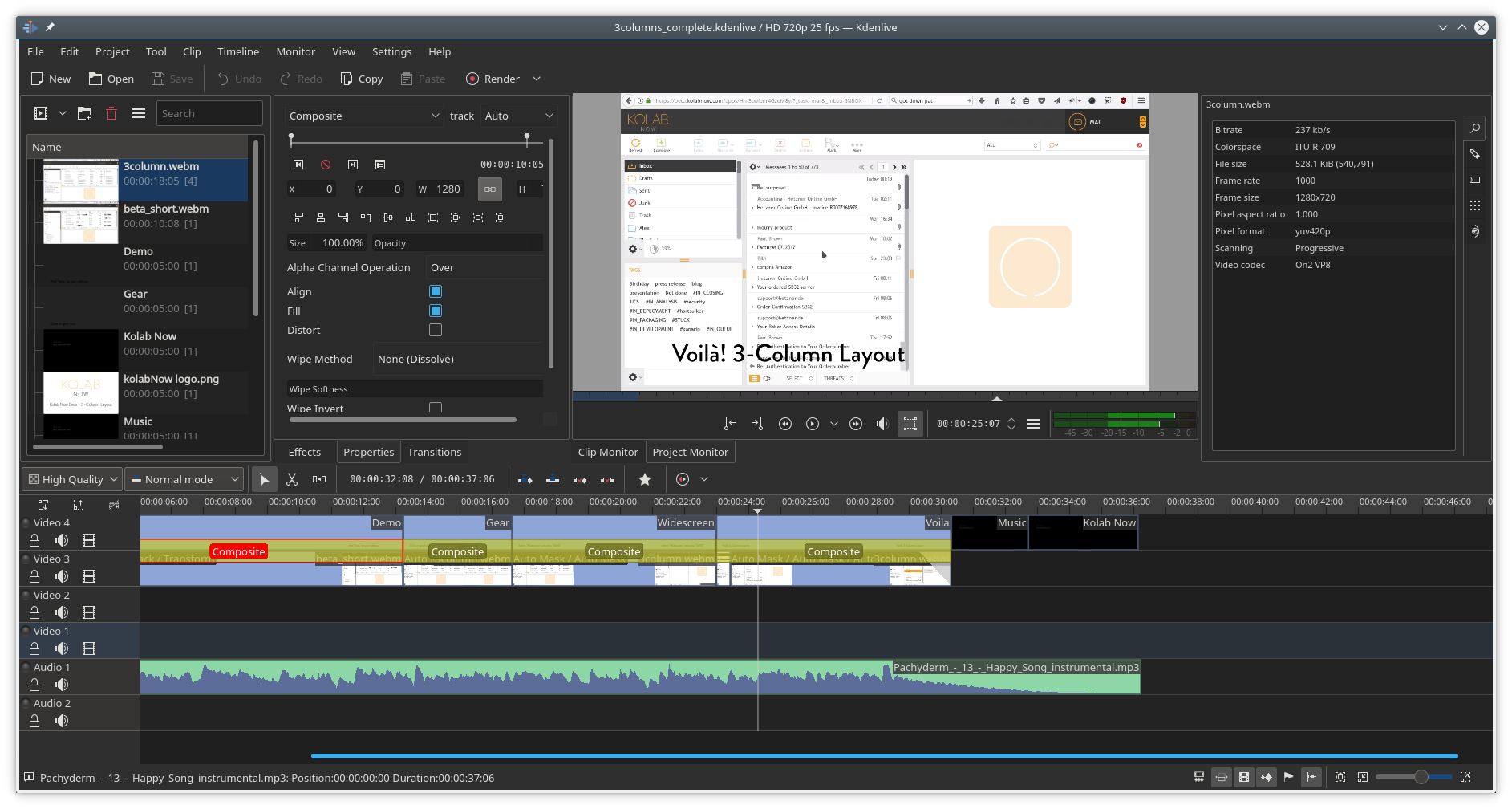
Kdenlive will be easier to use by the end of the sprint.Our intrepid developers are getting ready to make their way to Randa, the location for KDE's autumn coding sprint, and we are gradually finding out what they will be doing up there in the Swiss mountains.
As Valorie said in a recent blog post, accessibility is useful for everybody at some point or another. Clear, highly contrasted icons, easy to reach keyboard shortcuts, and scalable fonts are things we can all appreciate most of the time, whether we have any sort of physical disability or not.
With that in mind, Jean-Baptiste Mardelle will be working on Kdenlive, KDE's video editing software. He'll be reviewing the user interface; that is, the different panels, toolbars, etc., to make it easier to use for people who start editing for the first time. He'll also be working on packaging - creating AppImages and Flatpaks - so the latest versions of Kdenlive can be installed anywhere without having to worry about dependencies.
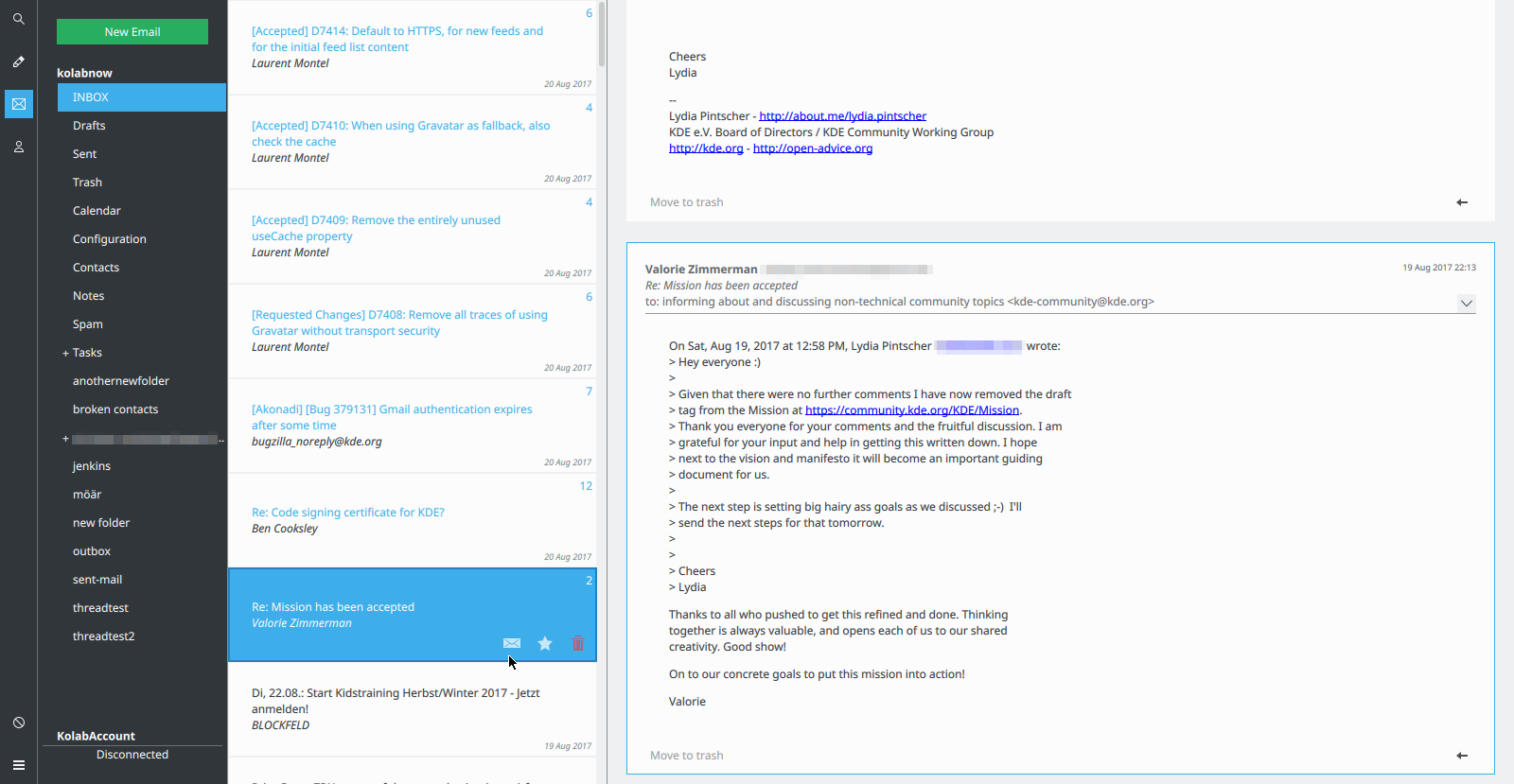
Kube is the new app for email, calendars, tasks,
notes and more.Marco Martin will be working on Kirigami, the framework that helps developers create apps seamlessly for desktops and mobile phones. His accessibility work will also extend to Plasma Mobile. If he has time, Marco says he would also like to work on Kube, a new groupware client to manage your emails, contacts, tasks, calendars and so on.
When asked what they would be working on, Christian Mollekopf and Michael Bohlender both chanted "Kube, Kube, Kube!". Although the work they will be carrying out is not specifically related to accessibility, one of the main aims of Kube is to offer a friendlier, more intuitive and more attractive user interface, making it easier to use than its alternatives.

KMyMoney will get consistent keyboard functionailty.Another dynamic duo, Thomas Baumgart and Lukasz Wojnilowicz, will be working on KMyMoney, KDE's personal finance manager. T & L will be working on making KMyMoney's keyboard functionality more consistent. They will also improve porting KMyMoney to Windows, creating an opportunity for a larger audience to use the app.
And then, of course, there will be the invaluable work of the organisers. Mario Fux is the main coordinator of the event, and he will be making sure everybody is fed and watered during the meetings. Simon Wächter and Fox will be helping developers by catering to their needs, plying them with Swiss chocolate, and dispensing hugs for moral support when their code misbehaves.
Essential stuff.
You too can help make Randa 2017 a success -- contribute to our crowdfunding! A few euros go a long way to making KDE better for everybody.
Dot Categories:
-
Randa Meetings Team Announces Community Partnership with KDE e.V.
(KDE)
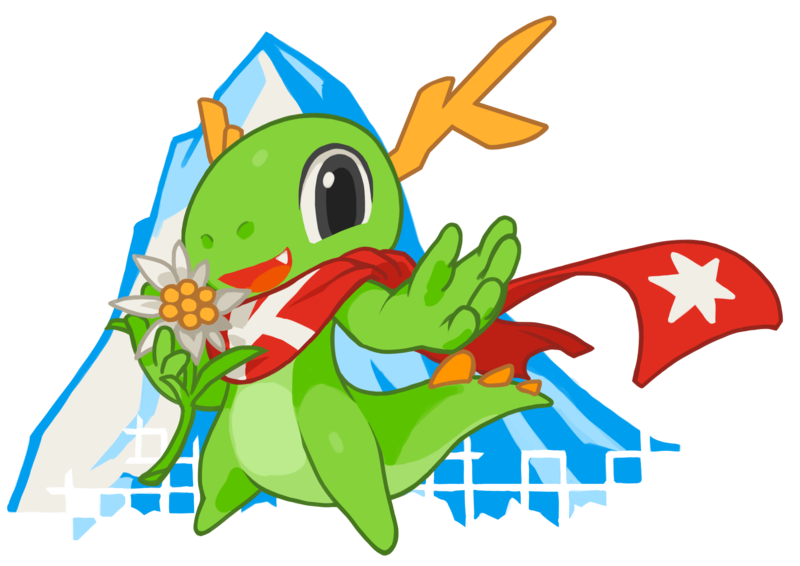
The team behind The Randa Meetings is pleased to announce a community partnership with the KDE e.V. The Randa Meetings is the largest sprint organized by KDE, where roughly fifty KDE contributors meet yearly in the Swiss Alps to enjoy seven days of intense team work, pushing KDE technologies forward.
For the past years the sprints were organized by a core Swiss team and supported by the KDE community. Organizing sprints was challenging, but the result always justified the efforts. To keep the yearly sprints going and make easier the work for the Swiss core team, the Randa Meetings have now become an official KDE e.V. community partner.
This decision allows the Randa Meeting to simplify their workflows like organizing fundraising and traveling reimbursements. It removes pressure from the organizers and allows them to spend more time on the sprint and their own personal affairs like family or the building of a new house.
The Randa Meetings will continue with a yearly meeting. For 2017, the date is already set to 10 September to 16 September. This year the meetings will be focused on accessibility and personal information management (PIM). We want to make our software accessible for people with visual disabilities and also to make our software accessible from different operating systems, different devices and with different user interfaces, such as graphical with keyboard and mouse, or touch or speech and other senses.
We look forward to greeting you in 2017 and wish you all a good new year!
Dot Categories:
-
Linux Application Summit 2019 about start in Barcelona
(GNOME)
The GNOME Foundation is very excited that Linux Application Summit 2019 is about to start in Barcelona, Spain. Linux App Summit 2019 (or LAS) is a joint collaboration between GNOME and KDE which will feature 3 days of talks from prominent members of the Linux developer community on Tuesday 12th November to Thursday 14th November, […]
-
GNOME Asia Summit 2019 to be held in Gresik, Indonesia
(GNOME)
The GNOME foundation is pleased to announce that GNOME Asia Summit 2019 will take place in Gresik, Indonesia between 11-13 October at the Universitas Muhammadiyah Gresik (UMG). This city has been known to the world since 11th century as a strategic trade center. It is located on the western side of Surabaya, the second largest […]
-
GNOME Foundation opens recruitment for further expansion
(GNOME)
Orinda, CA. Today, July 6th 2018, the GNOME Foundation has announced a number of positions it is recruiting for to help drive the GNOME project and Free Software on the desktop. As previously announced, this has been made possible thanks to a generous grant that the Foundation has received, enabling us to accelerate this expansion. […]
-
Consistency Update
(KDE)
By Niccolò Venerandi
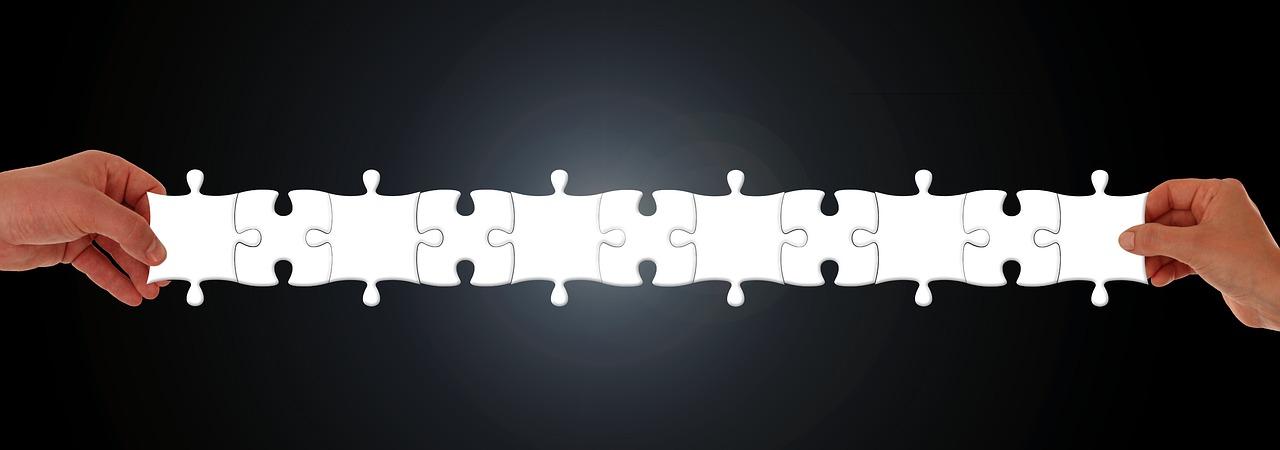
It's been a month since Consistency was announced as an official goal for KDE at Akademy. During this time, we have focused on setting up all the tools needed to support the goal and tracking already active consistency tasks. Here's an update on what we have done so far and the main tasks we're working on.
Community Page
We have created a Consistency page on the community wiki where you can learn what the consistency goal is and find out how you can easily get involved in it. Check it out, regardless of your level of technical expertise!
Matrix Channel
There is also a Consistency channel on KDE's Matrix instance. Access it through the webchat page or at consistency:kde.org. You are welcome to come in and join us to discuss anything related to the consistency goal!
Sprint!
A sprint is in the works. If you would like to participate, join in the discussion and come and discuss the time and the place on the Matrix channel as well.
Phabricator Workboard
We created a Consistency workboard so you can track all the tasks and keep up with their development. You can add yourself as a member or watcher to receive Phabricator updates.
Tasks are organized into the following categories:
- Reported shows consistency problems that still need to be addressed, but are currently not being worked on, or are not actively developed yet
- VDG Discussion lists tasks that the VDG (Visual Design Group) are discussing
- HIG Specification shows tasks that are waiting for an HIG (Human Interface Guidelines) specification so they can be developed in a consistent way
- Under Apps Implementation you can find tasks that are actively being worked on
- Meta contains all the tasks that are not exactly consistency problems, but are related to the consistency goal in some way
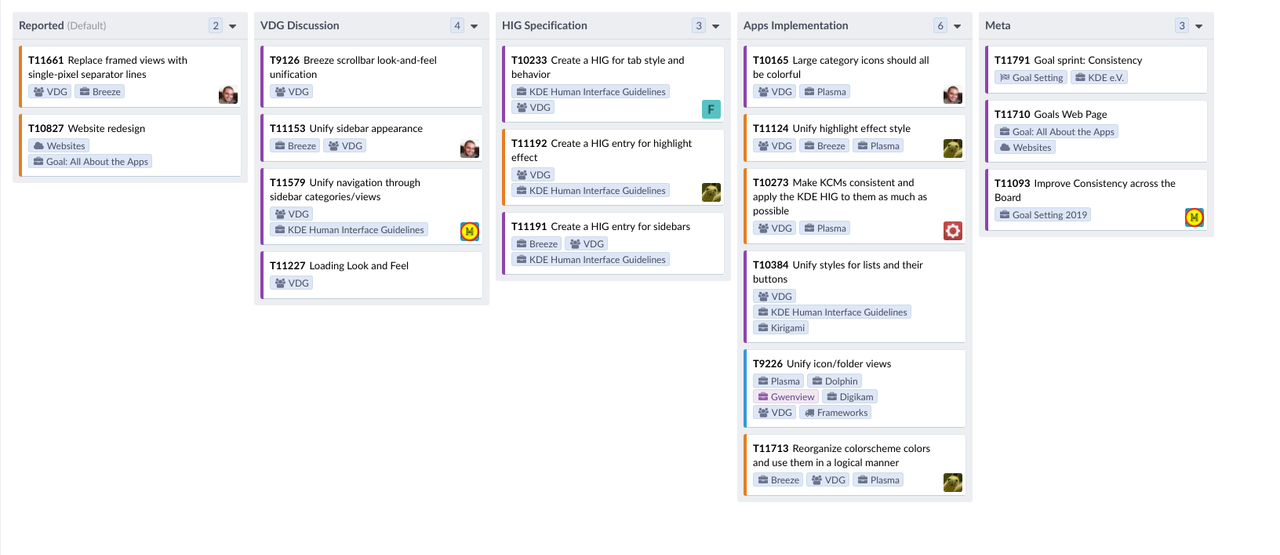
The Consistency goal's workboard.Consistency Tasks
There are already many tasks in the Consistency project. Some tasks are new, some existed before. Many of these tasks are quite interesting, so read on to get an idea of what lays ahead for this goal.
Unify Highlight Effect Style
This task was already in progress when the Consistency goal was selected, but it is nevertheless a great example of what we'd like to see happen in the goal.
Currently, Plasma has a discrepancy in its highlight effect. The first kind of effect is a plain rectangle using the highlight color, while the second one is a rounded rectangle with an outline and semi-transparent background. Although the former is more common, we think the latter is more appropriate to use in all situations.
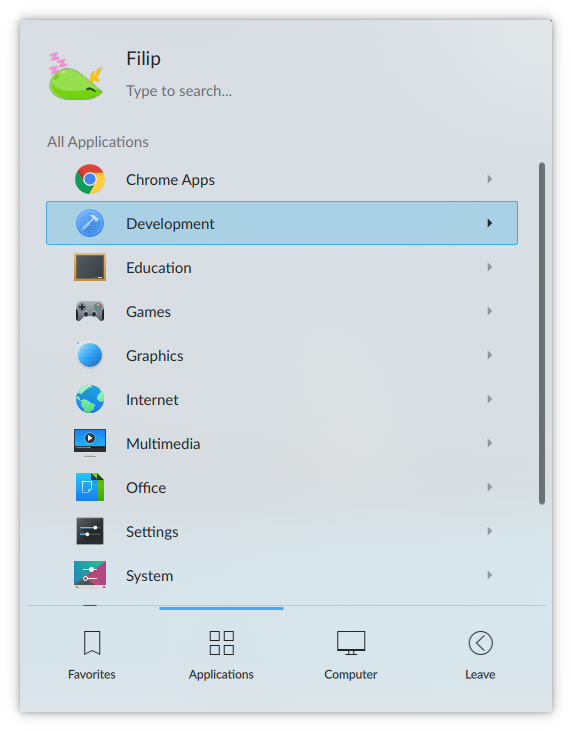
Here's the correct highlight effect in Plasma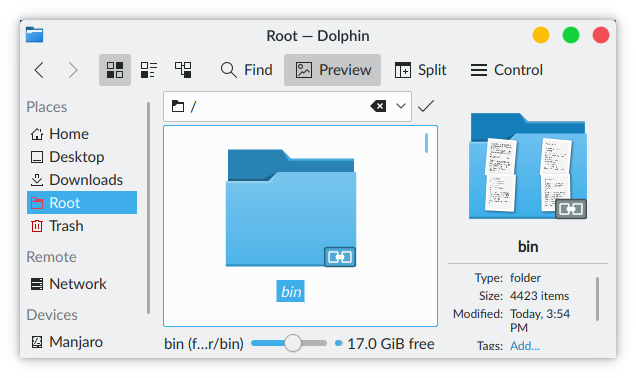
Here's what it looks like in Dolphin now.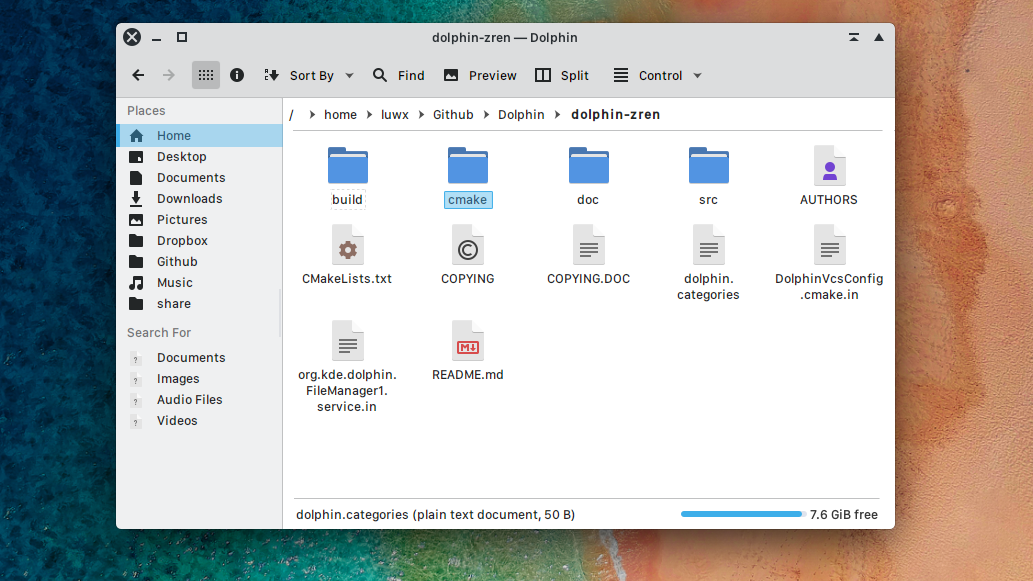
Dolphin mockup showing correct highlighting.A few more examples of what the new highlight could consistently look like in various use-cases:

Big icons sidebar highlight.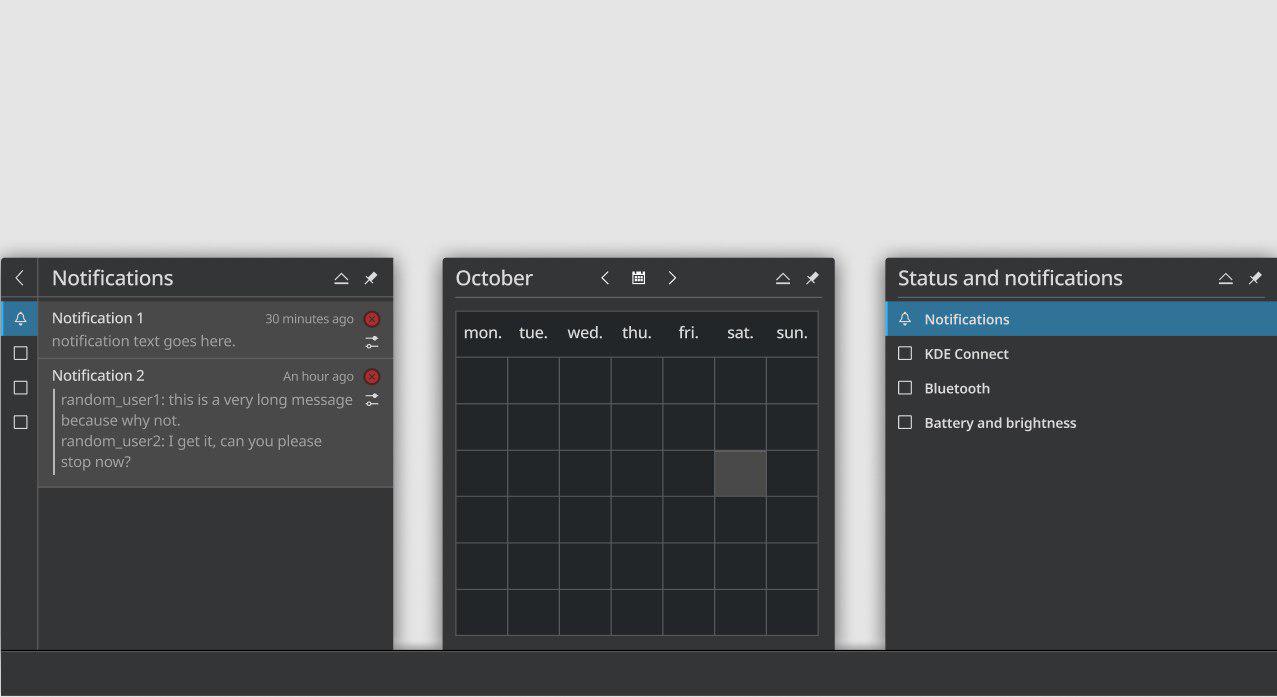
In plasmoids.
In menus.This is a great example of what consistency can be: not simply applying the same style everywhere, but finding something that a single app does very well, and bringing that to all the other apps. Noah Davis is actively developing this task, and he's doing a great job!
Unify Sidebar Navigation and Appearance
These tasks originated directly from the Consistency goal.
Sidebars are used in many applications and it would be great that they were consistent. There are two main aspects to this: the type of sidebar (system settings-like lists, big square icons, etc.) and the navigation within the sidebar (tabs, combo boxes, etc.).
What is the best solution? That part is currently under discussion. We welcome everyone's opinions on the matter or, even better, an expert assessment on the feasibility of each of the options.
Let's quickly illustrate some options:
For the sidebar appearance, the current main option relies on using lists and big square icons, depending on the number of elements:

Sidebars.On the other hand, the option for navigating sidebar views includes tabs that become icons-only when horizontal space is insufficient, vertical tabs on the left, and combo boxes:

Option 1.
Option 1b.
Option 2.
Option 3.Furthermore, Nate Graham is focused on making sure that all big icons displayed in sidebars are colorful. He has already fixed a lot of them, and only a few are missing that we know of. Finally, there's also a task to create an HIG specification for sidebars as soon as the discussion settles. We welcome help with any of these tasks. :-)
Website Redesign
This task was already ongoing when the Consistency goal was chosen and it aims to modernize old web pages that follow obsolete styles. There are many of them and some are well-hidden. Carl Schwan created and works on this task alongside many other contributors. Check it out and see if you too can find any old websites that need updating!
That's the end of this update!
If you would like to help out, come join us in the matrix room and let's make KDE software more consistent together!
-
Interview with Nathan Willis, GUADEC Keynote Speaker
(GNOME)
GUADEC 2014 is almost upon us, and we are talking to the three keynote speakers who are lined up for this year’s conference. Nathan Wills – LWN editor, typeface designer and author – is one of these keynote speakers. His talk, titled Should We Teach The Robot To Kill, addresses issues relating to Free Software […]
-
Akademy 2013 Day Two
(KDE)
Dot Categories:
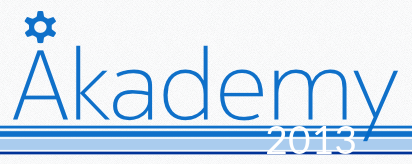
Akademy 2013 in Bilbao finished its first day in grand style with a party and great music. Day Two had another impressive line-up of talks. Day Two official business wrapped up with sponsor presentations and the Akademy awards.
-
Translation Workshop in Indonesia this Weekend
(KDE)

The KDE Indonesia Community will once again hold a Kopdar (local term for BoF). This meeting is the second meeting after the successful meeting in 2018. The activity will be held this weekend with talks and activities about translating KDE software into Indonesian. The main event is for KDE fans in particular and Linux in general to collaborate in KDE translation.
The event will be held on:
Day: Saturday, 23 November 2019
Time: 19.00 (UTC + 7)
Venue: Midtrans Office Jl. Gandok Baru No.46, Sleman, Yogyakarta
Speaker: Wantoyek
Topic: The First Step to Becoming a KDE TranslatorThe purpose of this event is to invite KDE activists to participate in contributing to the community, especially as translators. The KDE Indonesia community also opens opportunities to donate activities for anyone who wants to support this activity, please contact Rifky Affand (rifki.affandi3@gmail.com). See you in DIY Yogyakarta, KDE lovers!
To register go to the registration form and join the KDE Indonesia Telegram channel.
-
GNOME 3.26 Released
(GNOME)
The GNOME Project is excited to announce the release of version 3.26, the latest version of GNOME 3. The new version is the result of six months’ hard work by the GNOME community, and comes packed with improvements and new features. Announcing the release, Matthias Clasen of the GNOME Release Team, said “We are happy […]
-
Apps Update for December
(KDE)

Creating new applications is the easy part. Maintaining them, making them safer and faster and adding features that make them more useful to users is what marks the difference between one-shot wonders and solid tools you can trust and enjoy for years. That is why KDE developers are constantly renewing and updating their applications, making them more reliable, more useful, and in general, just better.
What follows is just a minor sample of what you can expect from the latest round of updates for applications made by the KDE community over the last month:
Calligra Plan is Back
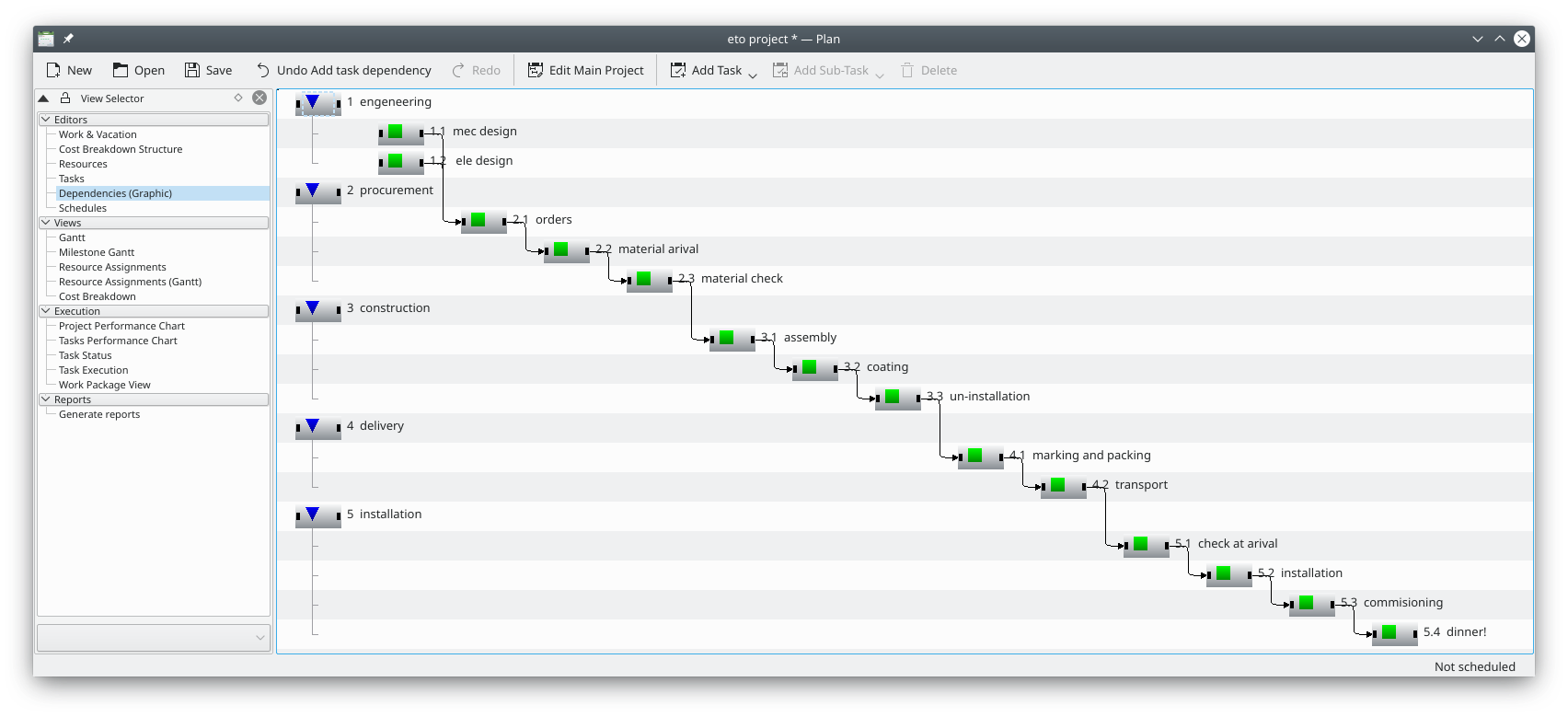
Calligra Plan lets you plan your projects in detail. Calligra Plan, KDE's project planning and management tool, gets its first big update in two years.
In case you were not aware, Plan helps you manage small and large projects which require multiple resources. In order for you to model your project, Plan offers different types of task dependencies and timing constraints. You can define your tasks, estimate the effort needed to perform each, allocate resources and then schedule the project according to your needs and the actual resources available.
One of Plan's strengths is its excellent support for Gantt charts. Gantt charts help you plan, coordinate, and track specific tasks in a project. Using Gantt charts in Plan you will be able to better monitor your project's workflow.
Kdenlive Pumps up the Volume

Kdenlive rocking a brand new audio mixer. Kdenlive developers have been adding new features and squashing bugs like crazy -- the latest version alone comes with more than 200 changes.
A lot of work has gone into improving support for audio. In the "bugs solved", department they have gotten rid of an error that would eat up memory. They have also made saving audio thumbnails much more efficient.
But the most exciting new feature is that Kdenlive now comes with a spectacular sound mixer (see image). Developers have also added a new audio clip display in the clip monitor and the project bin so you can better synchronize your moving images with the soundtrack.
Für Elisa
Talking of sound, Elisa is one of KDE's most popular up-and-coming music players. Elisa belongs to the deceptively simple, very light, very good-looking variety of players, with an intuitive and elegant interface and, in its latest version, Elisa has upgraded its looks even further to adapt better to High DPI screens. It also now integrates better with the looks other KDE applications.
Indexing music files has also improved and Elisa now supports web radios and comes with a few examples for you to try.
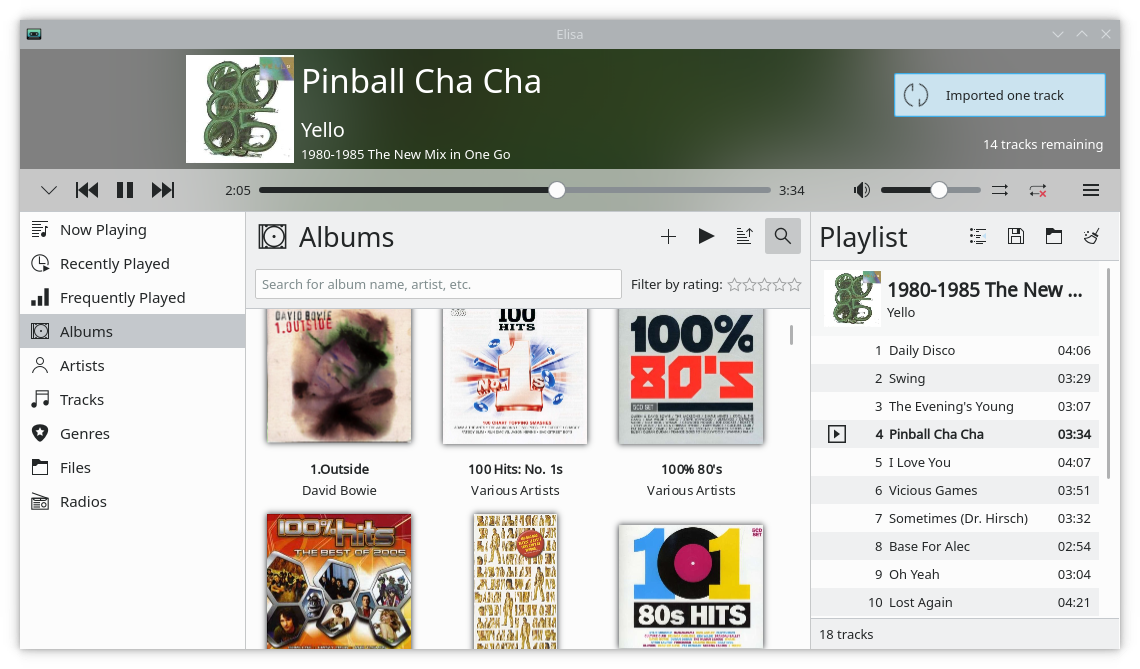
The Elisa music player.KDE Connect: Let Your Phone Rule your Desktop
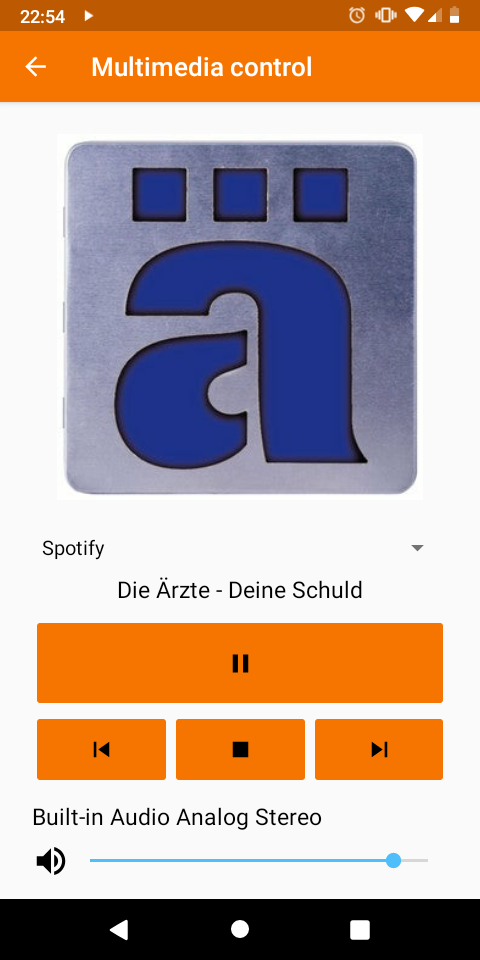
KDE Connect now lets you control
the global volume of your system.Most people who get to know KDE Connect, end up raving about it just because of how darned useful it is.
The latest version of KDE Connect packs even more features. One of the more noticeable is that there is a new SMS app that lets you read and write SMS from your computer with the full conversation history.
Developers are also adding new functionalities to existing features to make them even more useful. For example, you could already use KDE Connect to control the volume of media playing on your desktop, say, in VLC. But now you can use KDE Connect to also control your system's global volume from your phone. When giving a talk, you can control your presentation using KDE Connect to flip forward and back through your slides, and apart from integrating with other KDE apps, you can now also send files from Thunar (Xfce's file manager) and Elementary applications such as Pantheon Files.
Talking of other platforms, you can now run the mobile component of KDE Connect not only on Android, but also on all those mobile Linux platforms we'll be seeing in upcoming devices like the PinePhone and the Librem 5. The new version also provides features for desktop-to-desktop users, such as media control across desktops, remote input, device ringing, file transfers and running commands.
And Much More
But that is not all by any means: Dolphin, Spectacle, Okular and dozens of other applications have included new features you are sure to find useful. Even more projects, broaching apps, libraries and frameworks, have tweaked their code making them more stable and secure.
If you want to get an idea of the full range of changes, visit the official release announcement, or check out the changelog for every single detail of what has changed.
Getting applications made by KDE is also now easier: most are now available as Flatpaks, Snaps and AppImages. You just have to download them and they run straight out of the box. Many programs are also available for more platforms, such as Android, macOs and Windows. Krita and Okular have been available in the Microsoft Store for some time now, and they have recently been joined by Kile, a user-friendly LaTeX document editor.
Distributions will be updating their own repos and making the new versions available to Linux users over the next few weeks. Look out for your updates!
-
2017 year in review
(GNOME)
With the start of the new year let’s take a moment and remember 2017. 2017 represented a strong year for the project, with another two releases with large technical advances. We have seen growing numbers of partners, new advisory board members and a wider adoption of GNOME on several distributions. During the year, The GNOME Foundation […]
-
QtCon Closing Keynote with Julia Reda MEP
(KDE)
The talks are over after the three days of QtCon Akademy 2016 which means the BoF sessions and hacking days are about to begin. To close the talks at the conference we had a finishing keynote by Julia Reda, Member of the European Parliament and member of the Pirate Party.
She began by saying that on a fundamental level government is all of us, and it provides the infrastructure for our culture. Software used by the government is also a public service and the only philosophy that takes responsibility for that is free and open source software. Getting governments to use free and open source software is more important then ever because of the importance of technology in society. Computers are no longer limited to some parts of our lives, they are integral to everything we do. She gave the example of the VW Dieselgate scandal which is linked to cars being computers on wheels. There are no check that the software that is tested by regulators is the same that is run by the car hardware. Another interesting aspect is limitations on diesel control can be turned off to save the engine which means in practice they do this a lot and don't even need to tell the regulators. VW had a function programmed into the car which turned off the fuel saving if it deviated from the testing procedures.
Another area were we see the importance of software is robotics. A friend who wears a cochlear implant hearing aid has software which can control what you hear. Software on a pacemaker can be more scary. The source code for her friend's pacemaker had a bug and to test it they had to put her on a treadmill to debug it as there was no other way with the code not being available. Julia wants to know what software is run on her body. The EU parliament is discussing this issue.
An older debate is the use of technology in elections. In US voting infrastructure isn't considered critical infrastructure so it's not treated like an issue even when it has known problems. It's important to be able to inspect any software which has important functions. A more social issue is the debate about whether Facebook algorithms can influence elections. Predictive policing can encourage racist stereotypes, if that's done with software and we don't know how it works any biases can be very dangerous.
If you have Windows 10 running on your fridge there are more fun ways your software can fail. In some fields you might become legally barred from inspecting and tinkering your hardware. Freedom to tinker is important for education and also autonomy and it should be protected in a similar way as a freedom of speech. Information is governed differently from physical goods. Books can have owners but e-books are licensed and can't necessarily be given to your children when you die. Manufacturers will try to get us to rent things rather than buy them. There are tractors where the manufacturer told the owners they could not modify the tractor because that was not in their license. Circumvention of technological protections (such as DVD encryption) should be allowed. Even though these common sense demands were supported by the EU parliament, the EU Commission's proposals are different and e.g. want charges on news aggregators. There are no positive developments yet in copyright to give us more control. Another concerning area is trade secrets, which started as defending uncompetitive behaviour. If you break into the office of a competitor and steal plans that would be covered. But now manufacturers can claim the software is a trade secret and the regulator can't see it, which makes no sense. The US is introducing this into trade agreements to stop say China reading the software from US companies, so we have to make sure governments at least are able to see the software.
There are social developments that make free software significant. Some companies will restrict functions on their products by software which is dangerous. Finally there are moves for laws on what software can be installed on wifi hubs. Manufacturers should make sure users don't use the wrong spectrum but to allow competition, the US FCC has insisted you should allow 3rd party software. So we may have to have trusted computing type signed images for routers which makes installation of Linux on them much more challenging. What can government do about these issues? It's important we make the point governments rely on free and open software. Governments need to start taking responsibility of free software. There's a Prototype Fund in Germany where money is given to free software projects and helps with bureaucracy. With HeartBleed and ShellShock we saw a lot of infrastructure relies on free software but there's no responsibility from manufacturers to take care of it. The EU has started FOSSA, a project to audit free software. Asked in a survey which projects the EU should audit, most votes were for Apache HTTP and Keypass. The 2 year pilot project is coming to an end but they want to continue it and get a permanent budget. Also they want a bug bounty budget. In the future it's important to work within the system and build networks with free software communities and the EU commission. In Bulgaria and the US there are source code policies, they are not perfect but the US has a goal of publishing 20% of software as open source which is a lot better than many other governments. The EU commission has an open source policy but it only commits to not disadvantage open source solution in procurement. So her call for action is to move to a sustainable public procurement system and every government in the EU have a free software policy. The goal should be to make governments not just tolerate Free Software but to promote and improve it.
To close the conference we had the annual KDE Akademy Awards and finally representatives of KDAB, KDE, FSFE and VLC came on stage to thank the organisers and wish us a successful onward conference with Akademy.
-
Plasma rocks Akademy
(KDE)
KDE's yearly world conference - Akademy - was held last week in Almería, Spain. Lots of interesting things happened in the Plasma-verse during Akademy 2017.
State of the Union
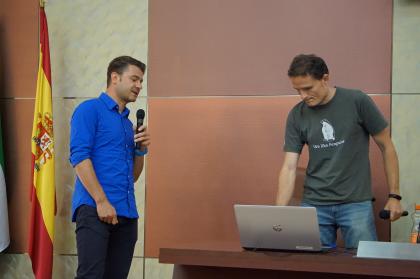
Sebastian Kügler and Marco Martin. Right after the first day's keynote (slides), Marco Martin and Sebastian Kügler caught the general audience up in their presentation "Plasma: State of the Union". Sebas talked about how the architecture around Frameworks 5 and Plasma 5 worked out very well, and how the 5.8 LTS release was received positively, especially by the users who value stability and predictability.
Marco then presented a number of new features that have been added to Plasma since last year's Akademy and that are planned for the upcoming 5.11 release. There is the improved integration for web browsers, better support for touchscreens, enhancements in the taskbar, return of the App Menu (Global Menu), encrypted volumes through Plasma Vault, more elegant artwork, a redesign of the System Settings user interface, and many more.
The KDE Store has gained a lot of traction since its relaunch at Akademy 2016, and now even allows its contributors to receive donations directly from happy users. (Full disclosure: Your editor was able to buy a pizza last week from donations coming through this new feature in the KDE Store).
Plans for the future of Plasma include getting the Wayland port ready for end-users, and thereby delivering on the promise of smoother graphics, a leaner graphics stack, better protocol semantics, improved high-DPI support and more features for touchscreens and convertible devices (such as edge-swipe support).
Plasma's Vision
Another talking point which deserves a special mention is Plasma's vision statement. The statement had been discussed on Plasma's mailing list and on KDE's Phabricator collaboration tool over the last couple of months, and it is now finalized. Plasma's vision statement reads:
"Plasma is a cross-device work environment by the KDE Community where trust is put on the user's capacity to best define her own workflow and preferences.
Plasma is simple by default, a clean work area for real-world usage which intends to stay out of your way. Plasma is powerful when needed, enabling the user to create the workflow that makes her more effective to complete her tasks.
Plasma never dictates the user's needs, it only strives to solve them. Plasma never defines what the user is allowed to do, it only ensures that she can.
Our motivation is to enable actual work to happen, across devices, across different platforms, using any application needed.
We build to be durable, we create to be usable, we design to be elegant."Its cornerstones are stability, usability (which includes features to make the users' lives easier) and elegance, meaning that the team aims to create stable software that helps users get their job done elegantly, but swiftly and with pleasure. For a more detailed explanation of Plasma's vision, head over to sebas' weblog.
Halium Unifies Mobile Linux
Bhushan Shah, maintainer of Plasma's user interface for mobile devices, talked in detail (slides) about the latest endeavour - Project Halium. Halium is a collaboration that aims to share the development effort among several groups. By creating a common base, Project Halium wants to make it easier to bring Plasma Mobile to a wider range of devices. In just a few months, Halium has not only allowed Plasma Mobile to run on its new reference device (the Google Nexus 5X), but has also provided the basis for ports to the Fairphone 2 and a few other handsets.
With other Free software mobile stacks (such as Ubuntu Touch and Firefox OS) being discontinued, Plasma Mobile positions itself as the best option to create truly Free and community-developed mobile devices. While its development is not very fast-paced, its continued improvements begin to bear fruit. This makes Plasma Mobile an increasingly attractive platform for people and companies that want to escape the Duopoly of today's smartphone market and bring something entirely new to the table.
Kirigami Makes Convergence
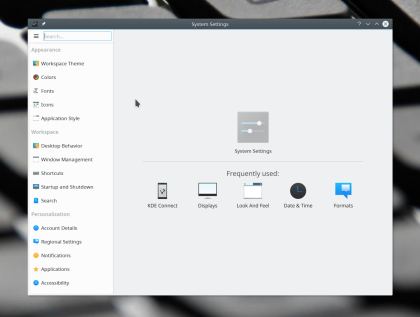
System Settings' new user interface. Most of today's applications are written using QWidgets, which is still the most powerful tool for certain kinds of applications. QWidgets does have some graphical limitations, which may sound bad, but this limitation leads to more consistent UIs across applications. Using QWidgets makes it difficult to deviate from the human interface guidelines (HIG) too much, thus enforcing visual consistency.
This is about to change. Qt is investing heavily into QML, which has fewer graphical limitations, putting more power into developers' hands. A side-effect, however, is that it makes it (too) easy to create applications visually and interactively inconsistent with each other.
Kirigami was born both as a human interface guideline (HIG) and a framework implementing it. Kirigami has been stabilized over the past year and will be released together with KDE Frameworks 5 starting August 2017.
Kirigami provides the skeleton for applications, allowing developers to write visually and interactively consistent applications with little effort. While it seems that Kirigami limits the endless flexibility that QtQuick-based UIs offer, it solves common problems of in-app navigation. Moreover, it solves the lack of consistency across applications, providing uniformity and reducing the need to 'learn' a new application. In order to think outside of the box, you need a box in the first place, and Kirigami provides that box.One example of a Kirigami app is Koko, a simple QML-based image viewer. Although Koko never received any real designer input, it has been resurrected as a Google Summer of Code project by Atul Sharma, and has been redesigned to be a textbook case for Kirigami. Other Kirigami-based applications are Discover (Plasma's software center), the new System Settings user interface (to be released with Plasma 5.11), and of course, Kirigami's first adopter: Subsurface Mobile, an application for logging scuba dives. Kirigami provides a morphing UI, which allows creating applications that work equally well on desktop and mobile. With Kirigami, creating a convergent application is a breeze.
The main target platforms for Kirigami are Plasma Desktop and Plasma Mobile, with the convenient side-effect of working nicely on Android. While we care a lot about following the look of Material on Android, we're not interested so much in the feel. With Plasma Mobile, we want to innovate without the legacy that Android and iOS have on their top-heavy UIs. Such interfaces are very hard to use with a single hand on big screen phones, and this is something we want to avoid.
Kai Uwe Broulik wins Akademy Award for Plasma
Kai Uwe Broulik, a Plasma Hacker extraordinaire, was lauded an Akademy Award this year for his work on Plasma. As the developer behind features like the App Menu, web-browser integration, and many other cool features big and small, Kai is a tireless and positive force that many of his teammates follow as a role model. The award, which also reflects positively on the rest of the Plasma team, is well-deserved and received gratefully.
Swapnil Bhartiya interviewed Kai shortly after the Akademy Awards ceremony. In this interview, Kai reveals his ideas and thoughts on Plasma and the desktop in general. It's well worth watching.
Birds-of-a-feather
On Monday, the Plasma team held a day-long birds-of-a-feather (BoF) session. BoFs are collaborative meetings where everyone with the same interest is welcome to participate. The sessions are focused on making plans and finding solutions for problems that need face-to-face interaction. Naturally, they are also a great opportunity to look into the developers' kitchen. Let's take a peek!
The Plasma team plans to improve support for convertible devices (laptops with touchscreens and detachable keyboards). In order to do that, some improvements to the virtual keyboards are planned.
Other aspects that need improvement include screen rotation, sensors support, and the appearance of the UI when used with one's finger. Furthermore, the team talked at length about structuring the (somewhat dynamically grown) battery of QtQuick imports in a more logical way.
Finally, a BoF session on Wayland resolved a number of problems in applications using Wayland, leading to direct results. For example, KMail will support the Wayland display server natively in an upcoming releases.
Changes planned for Plasma Mobile include a more efficient and clean implementation of the top panel, better backend-sharing between desktop components and mobile UIs, and better support for third-party applications, especially those left in the rain by the demise of Ubuntu Touch.Akademy provided a great opportunity to prepare for the next big leaps in different areas of Plasma. As always, it was also a wonderful opportunity for the Plasma team to get together, socialize, and keep working as a team of friends.
Dot Categories:
-
Wednesday Akademy BoF wrapup
(KDE)
Wednesday is the third and for many people last day of BoFs, as people start to head off home. However hacking and some smaller meetings will happen tomorrow between those still here
Dot Categories:
-
GNOME 3.28 Released
(GNOME)
The latest version of GNOME 3 has been released today. Version 3.28 contains six months of work and new features by the GNOME community and comes with many improvements and new features. One major new feature for this release is automatic downloading of operating systems in Boxes, which takes the work out of creating and […]
-
Call for GNOME.Asia Summit 2018 Host Proposals
(GNOME)
The GNOME.Asia Committee is inviting interested parties to submit proposals for hosting GNOME.Asia Summit during the second half of 2018. GNOME.Asia Summit is the featured annual GNOME Conference in Asia. The event focuses primarily on the GNOME desktop, but also covers applications and the development platform tools. It brings together the GNOME community in Asia […]
-
Akademy 2017 -- Day 2
(KDE)
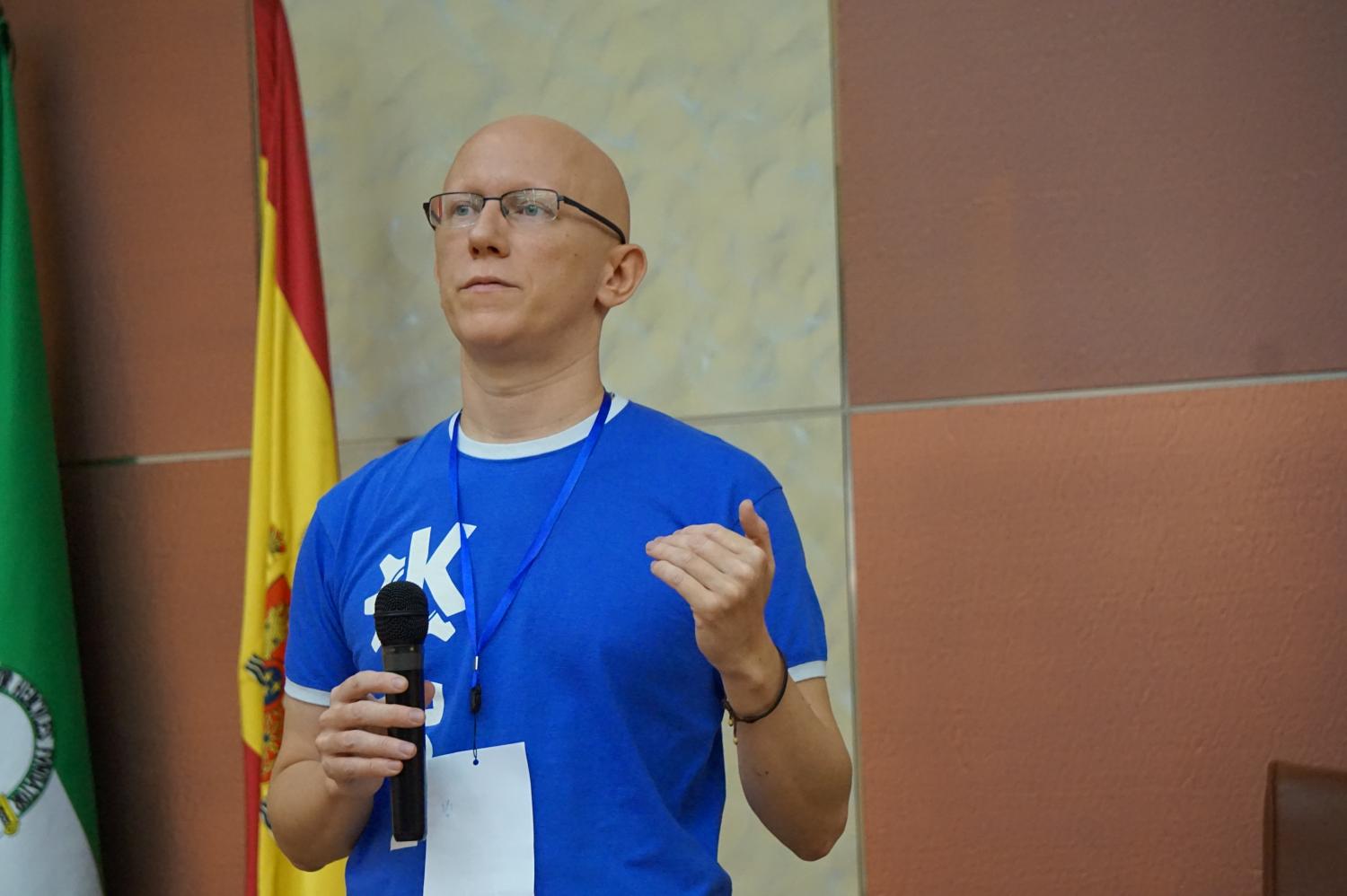
Antonio Larrosa advocates building
intracommunity relationships.Antonio Larrosa kicked off Sunday with his talk on The KDE Community and its Ecosystem. He expressed concern about what he perceived as an increase in the isolation of certain communities and laid out the advantages of working on intra-community relationships.
Later on in the day, Kevin Ottens gave his audience a taste of what Qt's 3D API can do in his talk Advances in Qt 3D. There are more and more applications that rely on 3D everyday, especially with the increase in popularity of virtual reality. Ottens introduced the tools Qt developers looking to include 3D into their programs and even treated attendees to a preview of a feature that is still in the works and that helps manage shader code.
Dan Leinir Turthra Jensen gave a very entertaining talk on Supporting Content Creators or Satisfying Your Inner Capitalist. Leinir laid out ways app developers could make enough money to be able to sometimes eat, while at the same time still feed their craving for developing cool stuff under free licenses.
Jonathan Riddell gave a demonstration of what Neonception would be like by running Neon inside Neon using Docker images. The point being that, apart from looking cool, as Neon comes in various experimental flavours, developers can run unstable versions in a container without endangering their main set up.
Jonathan gives a good explanation himself in the following video:
Ivan Čukić rounded off the day, invoking the Cthulhu of programming languages. In his talk C++17 and 20, he reviewed some of the more interesting features included into C++17, as well as those planned for C++20. Although some attendees would probably prefer C++ lay dreaming a few aeons more, new things like ranges, concepts, and coroutines may just convert some developers over.
About Akademy
For most of the year, KDE—one of the largest free and open software communities in the world—works on-line by email, IRC, forums and mailing lists. Akademy provides all KDE contributors the opportunity to meet in person to foster social bonds, work on concrete technology issues, consider new ideas, and reinforce the innovative, dynamic culture of KDE. Akademy brings together artists, designers, developers, translators, users, writers, sponsors and many other types of KDE contributors to celebrate the achievements of the past year and help determine the direction for the next year. Hands-on sessions offer the opportunity for intense work bringing those plans to reality. The KDE Community welcomes companies building on KDE technology, and those that are looking for opportunities. Join us by registering for the 2017 edition of Akademy today.
For more information, please contact the Akademy Team.
-
QtCon Day 2: Extended Track Coverage
(KDE)
There is so much about QtCon and all its diversity and enthusiasm right from the Traffic Cone hats to the Ratatouille to the parallel KDE, FSFE, Qt tracks that all of it can't be summed up even across numerous dot stories. So this article in particular aims at giving a detailed summary of some of the talks not covered in the previous dot story and a more detailed version of the lightning talks for those who prefer a quick read over watching videos.
Governments Migrating to Free Software
Sonia Montegiove gave a talk on the Migration of Italian Ministry of Defense, in which she detailed the process that they undertook to install LibreOffice suites on the computers of the IMD. Libreitalia, her organisation, works to create more awareness about LibreOffice and to spread the word about it. She gave the average novice person in the audience an idea of what FLOSS is using the particular example of Libreoffice. Libreitalia promotes LibreOffice in public administration, schools and other academic institutions. Last year that they signed an MoU with the Italian Defense Ministry to use LibreOffice in place of Microsoft Office. They are also in the process of adopting odf as the standard format for all their documents. Sonia explained that LibreOffice can be marketed to such institutions by emphasizing how the money saved by not buying proprietary software licenses can actually be used to invest in other processes and other resources for the organisation. She also mentioned that the Italian law states that organisations are supposed to choose and use a FOSS software over a proprietary software if it is equally equipped enough to serve the required purpose. In spite of such legal provisions, organisations still choose to go ahead with proprietary software. That might be changed by spreading awareness among them regarding the independence from software vendors that using FOSS software supplies. Besides the Italian government, the French government has 5 million PCs across 15 ministries that use FOSS and so does the Commitat Valencia on a different scale.
Sonia discussed the individual steps of acclimatizing the office staff to the change in their work stations and how to make the integration with the office suite as smooth and uninterrupted a process as possible with their existing IT infrastructure. It is also very important to start the migration process with communication. The managers and employees should know why they are using Free Software and that it isn't a makeshift solution. They should be absolutely convinced of the objectives and the philosophy behind moving to LibreOffice. The migration process was communicated to the people at the top ranks as well and there were also training sessions given to the office trainers and the internal support staff so that they can guide the people better with the process. Eight thousand migrations to LibreOffice have already been carried out and they also have twenty video lessons highlighting the differences between MS Office and LibreOffice. Among the future plans there is going to be a provision for additional training lessons by late 2016 and also for translations to sign language. She highlighted five questions as the main issues of migration that the end-user may ask, and they were mainly to do with justifying the user of the time spent in the process of migration, assuring them of a smooth process of adapting to the new system owing to the good support teams and community, clearing the myth about destruction/re-creation of existing data and documents, the hesitance in trying out something new and the doubts regarding the replaceability of the old software with the new one. Libredifesa, with it's large number of volunteers and the massive end impact on the FOSS ecosystem, can serve as an excellent reference for people involved in outreach efforts and looking for a successful model for a smooth migration process for the end users.
Qt track
As a part of the Qt track there were a number of interesting talks ranging from adaptation to car systems and Qt 3D to better testing tools.
Helio Chissini de Castro spoke of how the IT department at BMW Cars adapted QtCreator as their development IDE. When it came to embedded development, QtCreator was a strong choice since many developers of car IT have considerable experience and background in QT technologies and FOSS. Dr. Mashrab Kuvatov was the one who started and developed the project and it uses a head unit SDK with the concept of jail root to compile the yocto based system. Helio highlighted a few of the basic requisites that were essential for the specific usage of QtCreator for car systems and they included code completion from the native SDK, plugins to control the SDK and the respective toolchain and a seamless integration with the development environment and dynamic code compilation to code post installation. The current plugin requires modifications on the QtCreator main source code since it can't be compiled standalone and needs manual first setup to the SDK. It is also limited to particular network environments to the head unit. But the in-queue planning for the QtCreator Plugin includes improving the system to not need any external code behind QtCreator and to contribute upstream.
There was also a discussion of the possibility of the plugin compilation outside QtCreator. It is currently limited to Ubuntu Linux and requires custom packages and deploys only a clean setup and demands full source code recompilation on every new release. The eventual aim is to cover the most significant Linux distributions and to deploy the plugin on the distro QtCreator install base and to have a predefined setup for the SDK and to recompile the plugin only on new release. The code completion uses a modification of source code detection and is restricted to the old parsing model and it uses the SDK but not the system and there is no clear separation on what is native and what isn't. There shall be more efforts to improve upstream relationship to provide contributions to QtCreator's parent project and to reduce local maintenance and these changes and advances shall see an influx of a greater scope for QtCreator as the IDE of choice in numerous car IT departments all over.
Right after lunch, there was an interesting talk titled CityBikes, data policies and the big elephant by Lluis Esquerda. Citybikes started out as an android app for the local bike sharing system but when they had difficulties in procuring data since there was no open data available for them, they decided to expand Citybikes to a project providing open bike sharing data to everyone. Pybikes is a python library containing all the scraping logic that can give you access to bike sharing data from bike sharing networks across the world. And Pybikes provided the necessary data to Citybikes for it's own android application. And as a result, Citybikes was an API used by numerous developers who have adapted the app for Google Glass and IOS and also for different app uses. There was also a proper distribution displayed of the amount of data that they procured via scraping, via licenced deeds and via other sources and scraping was the major contributor. He also talked about the presence of PPAs (Public Private Partnership) which is when a private company makes an agreement with a public party like the city council to be able to use their data in exchange for the app or facility that they provide them with using the data. These leads to a monopolisation of the data and a closed control of it in the hands of the contracted private company and so there needs to be a proper awareness regarding Open Data especially for institutions like the City Council and how it would lead to better quality services like bike sharing if the data is openly accessible since many more people can work on it and keep on improving the system as opposed to a single corporation. Open Data shall lead to a better world and a better future, and Citybikes aimed to do just that by their magnanimous efforts in rallying for it.
Kevin Ottens gave a talk on Qt 3D basics and about the architecture and what the API looks like. It isn't just about 3D rendering but is multi purpose and not just limited to game engines. It has been designed to be scalable and extensible and flexible and gives you the ability to add more domains in the simulation since the core of the simulation engine is not inherently about 3D and so it can deal with several domains at once including AI, logic, audio and more and also allows you to write complex simulation systems. It is scalable since there is a frontend-backend split and the frontend is lightweight and is on the main thread and the backend is executed on a secondary thread where the actual simulation runs. For flexibility there are also domains that can be added via independent aspects. Qt3D provides both C++ and QML APIs and it integrates well with the rest of Qt. The entity component system which is an architectural pattern popular in game engines that favours composition over inheritance is used in Qt 3D to combine behaviours in your own objects. Essentially, an entity is a general purpose object and the entity gets its behaviour by combining data which comes from typed Components.
Using the example of a simple game he explained the difference between Inheritance and Composition using numerous cases and one such instance was adding the feature of emitting sound to the base class to add it to all entities but which wouldn't allow you to scale to more properties and similarly the complexities with multiple inheritance and mixed scale inheritance were demonstrated with appropriate examples. In Qt 5.7, Qt3D provides Qt3DCore, Qt3DRender, Qt3DInput, Qt3DLogic, Qt3DExtras and Scene3D which you can read about in depth on their site, and Kevin furthermore demonstrated the Hello Donut example to demonstrate the entity component model. The Qt3D Simulation wherein the Aspects have no API of their own and are all on the components was talked about as was Transformations and Spatial representations of simulations in Qt 3D. Geometries, materials, textures and lights and their available effects for the entities with Qt 3D were discussed and demonstrated via appropriate examples and what future developments can be expected in Qt 3D including animation, collision detection, geometry processor and physics aspect were talked about. Automating HMI and System Tests for Qt and QML frontends was, as the title suggests a demonstration of how testing can be automated and how system tests can be visually verified as well. The basic different tests including unit tests, system tests, functional tests, non-functional tests and integration tests were briefly talked about and the automation of some of them were discussed and demonstrated including checks of misplacement of buttons or text errors or sizing of text boxes and so on.
Harri Porten talked about Code Coverage for Qt C++ and QML code. The challenges posed by Qt applications in measuring code coverage were demonstrated and presented through numerous examples.
Lightning Talks
Among the lightning talks in room B09, Jesus Fernandez talked about OAuth and Qt and demonstrated it by using it to log in to a third party application using a Twitter social networking account. OAuth user login allows any user of the developer's app to authorise themselves on an ArcGIS portal and to access permitted secure resources without the handlage of the user's credentials by the application and the app receives a unique alphanumeric token that provides proof to the server of successful authentication.
Design, dummy! was a lightning talk by Jens on 10 easy rules to improve all your designs. He demonstrated numerous design faux pas via actual usage in his slide designs. His main advice was to not overuse colours and to stick with the standard gray, black and white since extravagant colours like red are used to draw attention to particular points instead of the entire application area. He also emphasized the importance of Font weight placement and size and the need for adequate space placements and limited menu/button/choice options for the design. He also mentioned that using too many animations is a design blunder and advised organizing the information to be conveyed to the user in a meaningful manner. He parted with the general mottos of not copying design, make your own as much as you can, study the design rules but to be sure to break them every once in a while.
The WikitoLearn lightning talk by Riccardo Lacconelli was a summary of the entire journey of the WikiLearn Community in the past year with their first official sprint in September and first partnerships in October and academical partnerships in December. They organised a larger sprint at CERN in March and then highlighted a goal to achieve in the coming years by getting twenty of the best educational institutes in the world to participate with WikitoLearn. With over 800 chapters created within a year and greatly surpassing Wikiversita's record, WikitoLearn is growing at a tremendous pace and has much more ambition for the future.
Daniel Pocock gave a talk on Postbooks which was essentially based on accounting using SQL- derived as a combination of PostgreSQL and QuickBooks and is the FOSS version of Xtuoke. It was originally developed in the U.S. and more adapted for use there ,but has now been expanded for global use and is used widely in the manufacturing and distribution sector. The double entry accounting system as an introduction to the basics of accounting was explained by him in terms of the debit and credit for your account and it was also demonstrated using PostBooks on the test data. He also gave some insight on how web based accounting was good for remote work and for accountants handling multiple accounts with multiple organisations whereas a Full GUI such as PostBooks was better for users with specific focuses and for those who require more options and advanced features and more flexibility.
Dot Categories:
-
Akademy 2017 ‒ Call for Hosts
(KDE)

Akademy, KDE's annual conference, requires a place and team for the year 2017. That's why we are looking for a vibrant, enthusiatic spot in Europe that can host us!
A bit about Akademy
Akademy is KDE's annual get-together where our creativity, productivity and love are at their peak. Developers, users, translators, students, artists, writers - pretty much anyone who has been involved with KDE will join Akademy to participate and learn. Contents will range from keynote speeches and a two-day dual track session of talks by the FOSS community, to workshops and Birds of a Feather (BoF) sessions where we plot the future of the project.
Friday is scheduled for the KDE e.V. General Assembly and a pre-Akademy party/welcoming event. Saturday and Sunday covers the keynotes, talks and lightning talks. The remaining four days are used for BoFs, intensive coding sessions and workshops for smaller groups of 10 to 30 people out of which one day is reserved for a Day Trip of the attendees around the local touristic sights.
Hosting Akademy is a great way to contribute to a movement of global collaboration. You get a chance to host one of the largest FOSS community in the world with contributors from over the world and be a witness to a wonderful inter-cultural fusion of attendees in your home town. You'll also get great exposure to Free Software. It is a great opportunity for the local university students, professors, technology enthusiasts and professionals to try their hand at something new.
What You Need to Do
Akademy requires a location in Europe, with a nice conference venue, that is easy to reach, preferably close to an international airport.
Organizing Akademy is a demanding and a resource intensive task but you’ll be guided along the entire process by people who’ve been doing this since years. Nevertheless, the local team should be prepared to spare a considerable amount of time for this.
For detailed information, please see the Call for Hosts. Questions and applications should be addressed to the Board of KDE e.V. or the Akademy Team. Please indicate your interest in hosting Akademy to the Board of KDE e.V. by December 15th. Full applications will be accepted until 15th January. We look forward to your enthusiasm in being the next host for Akademy 2017!
-
Mapbox steps in to help GNOME’s Maps application
(GNOME)
On July 11th, GNOME’s Maps application stopped working. Like all mapping applications, it relies on an online service to provide data. The service it had been using – MapQuest – discontinued free access to their data. When the service went dead, there were no longer any maps in Maps. Thankfully, it didn’t take long for […]
-
KDE at Asian FOSS conferences
(KDE)
It feels great to say that KDE has active contributors across the globe. Two KDE contributors recently presented talks in Asia about their work and encouraged new contributors to join us and get started.
Hong Kong Open Source Conference 2017
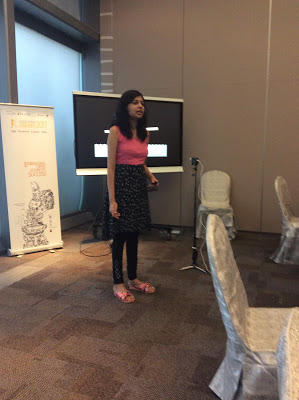
Heena in Hong Kong Heena Mahour presented a talk on ‘KDE : Journey of a SoK student to GCI organization administrator’ at Hong Kong Open Source Conference 2017.
HKOSCon is an open source event held in Hong Kong which aims to showcase and promote open source projects and activities happening across the globe.
Heena discussed her experience as a Season of KDE student which was her initial project and how she continued contributing to KDE afterwards. She also talked about recent trends in the community outreach program Season of KDE and her insight into the Plasma projects as an example of the vastness of KDE.
Heena also discussed the contributions made by KDE in Google Code-In, encouraging the students to get started with it. She provided information about GCompris and Pairs and a word cloud from Season of KDE Twitter posts and listed the contributions she had made so far.
It was amazing to help the new contributors join the KDE community in a similar fashion as to how her mentors helper her.
FOSSASIA 2017
Anu Mittal presented a talk on ‘K’oding with KDE at FOSSASIA 2017, Singapore.
At the FOSSASIA conference, many communities showcased their hardware, designs, graphics, and software. Anu talked about KDE, what it aims at, the various programs that KDE organizes to help budding developers, and how they are mentored. She walked through all the steps to start contributing in KDE by introducing the audience to KDE bug tracker, the IRC channels, various application domains, and the Season of KDE proposal format.
She also shared her journey in KDE, talked briefly about her projects under Season of KDE and Google Summer of Code. The audience were really enthusiastic and curious to start contributing in KDE. Overall her experience working in KDE has been very enriching. She wished to share her experiences to help budding developers get started.
It was interesting to see an emerging interest to participate and contribute to open source. KDE is one of the projects students are keen to contribute to. We do hope we, together as a community, keep it blooming more.
-
Donations within the EU are now handled through the Wau Holland Foundation
(GNOME)
The GNOME Foundation and the Wau Holland Foundation (Wau Holland Stiftung; WHS) have recently reached an agreement that will significantly improve the way donations to GNOME within the European Union (EU) are received and managed. Prior to signing this agreement, the GNOME Foundation was able to receive donations through many payment methods (including wires, checks, […]
L'actualité de cette partie est agrégé automatiquement à partir d'autres sites.
Contenus ©2006-2024 Benjamin Poulain
Design ©2006-2024 Maxime Vantorre
